This is a special study of Japanese tropical helmets by Nick Komiya, and is presented in four parts.
1939 March, Design Patent Granted for the Type 98 Sun Helmet Liner System
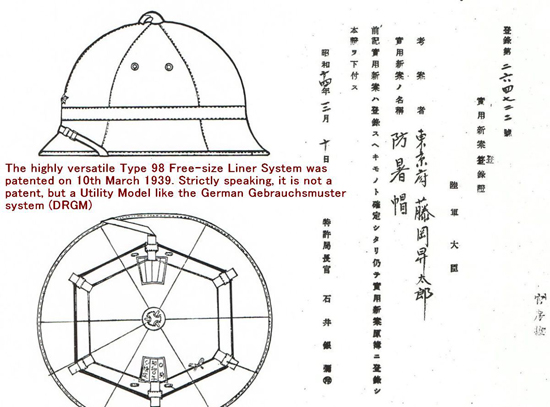
On 10th March 1939, the Patent Office Granted Utility Model Number 264722 to a Shotaro Fujioka of Tokyo for his invention of the flexible liner size adjustment system he developed for the Army’s Type 98 Sun Helmet. Fujioka was an employee of the Army’s Main Clothing Depot. The Army had applied for this on 2nd April 1937, just before sending the prototypes out for testing in Taiwan. Similar to a patent, but simpler to obtain, it is the same as the German Gebrauchsmuster system (when items are marked DRGM).
As detailed specs are not available for the Showa 5 sun helmet, which also had a size-adjustable liner system, I cannot say how different the Type 98 system was, but among the patent related documents above, one memo from the patent office confirms that as the system was sufficiently different from an “application from 1931”, the new Type 98 system deserved a separate patent. Whether the 1931 application they referred to was one for the Showa 5 liner system of 1930 is unclear, but it is clear that the Type 98 system was highly innovative in its own right.
1939 July, Disposal of Dead Stock Showa 5 Type Sun Helmets in Taiwan
Instead of using up all old stock as was usual for the IJA in launching new items, the Army uncharacteristically wrote off inventory of the old Showa 5 models as obsolete when the Type 98 came out. As Taiwan thus got stuck with dead stock of 10,115 pieces of the Showa 5 Type sun helmets, the decision was made to make use of them within Taiwan for field maneuvers and other events.
Showa 5 Models seem now to be extremely rare ( I could not find a single photo on the web ), but it is thus not far-fetched to imagine that some of these might still survive in some Taiwanese gardener’s shed.
1940 Feb. Shell Forming Mold Introduced
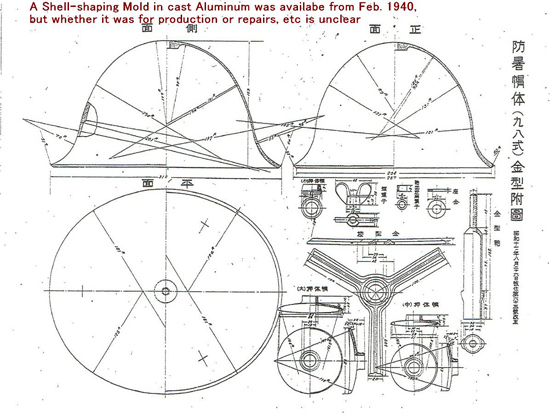
I am not sure how a mold figured in the production of what was mainly a weaving exercise, but on 2nd February 1940, they introduced a cast aluminum form for sun helmet shells. For felt shells, they must have required molds for production, but why then only from 1940 and not earlier? It may have also been for repair and reshaping. These came in three sizes, though the helmet came only in one size, so the only thing I can think of was that they gradually applied bigger forms to stretch the woven shell into the right dimensions and shape for the cloth covering to fit snugly. This spec was further updated on 26th August 1942, so as of that revision, the mold looked like below.
1941 April, Side Vent Grommets Discontinued (Type 98 Version 2)
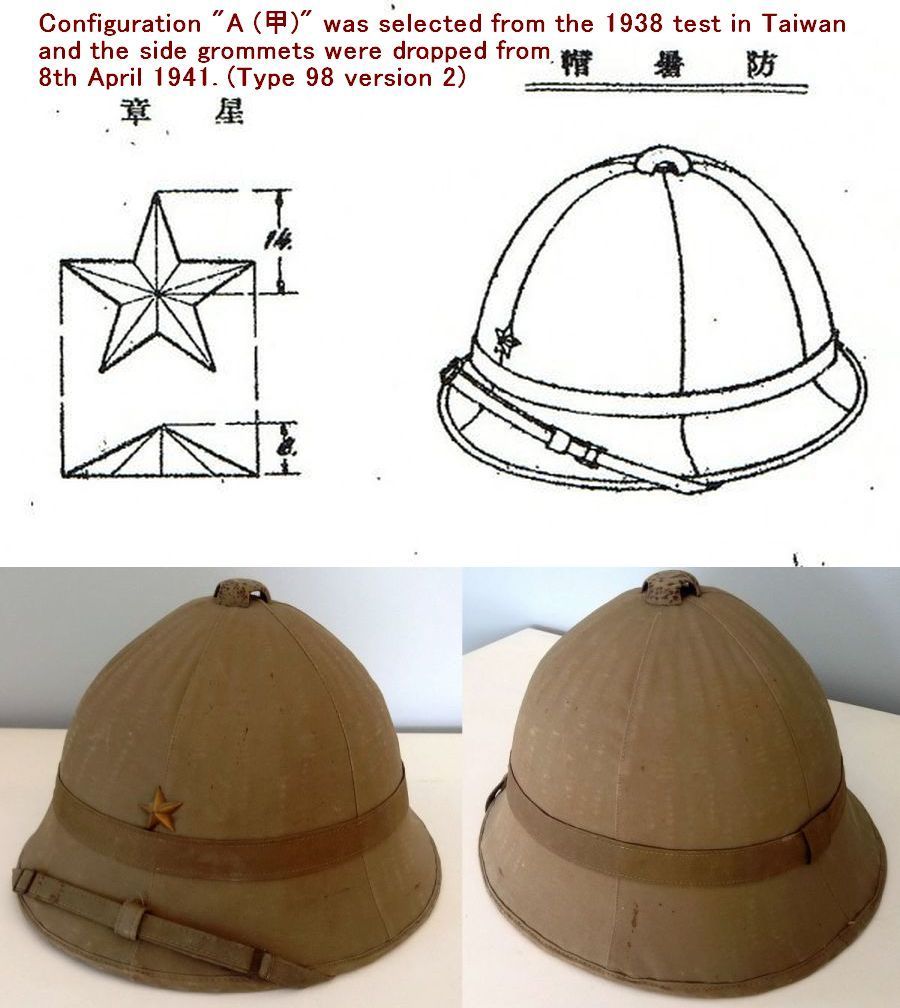
Army Ordinance 17, dated 8th April 1941 announced the deletion of the side vent grommets from the Type 98 Sun Helmet. So only the lidded vent on top remained. Thus from the 1938-39 field test they decided to take the ”Type A 甲” configuration.
1941 June/July, Testing of Sun Helmets without Top Vent
Merely 10 days after announcing the deletion of the side grommet vents, on 18th April 1941, a notice already went out that yet another round of tropical gear testing was to be conducted that year from early June till early July in Tropical South China (Either in Guandong or on Hainan Island).
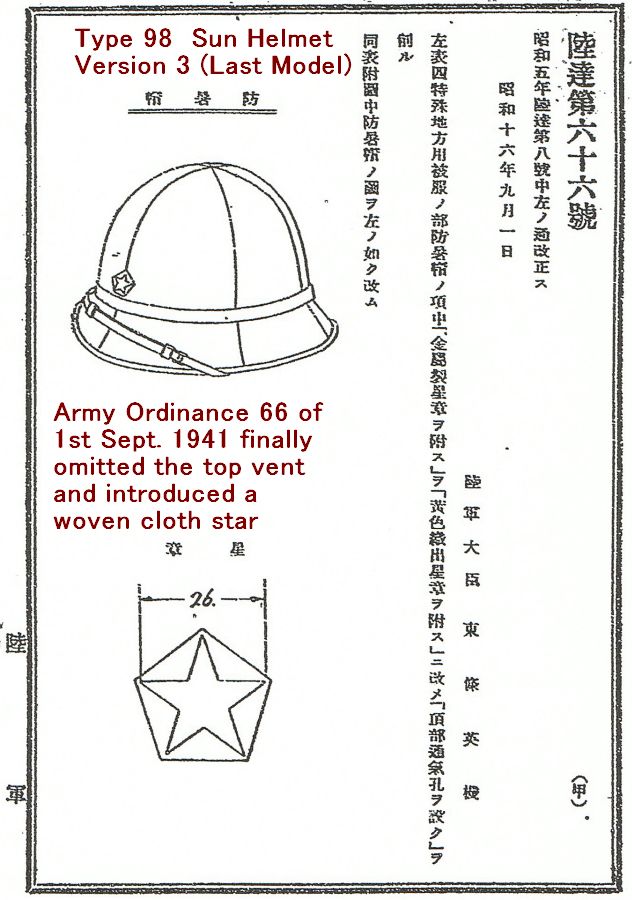
The prototypes to be delivered to Guandong by end of May included 250 sun helmets with the top vent and 250 without any vents at all. It appears that the main aim of dropping the top vent was to reduce unnecessary damage during manufacturing, judging by the phrasing used, but I can see that weaving shells without a hole on top would be much easier and less problematic.
These prototypes without the vent probably still had metal stars, as no mention is made of the woven cloth star insignia. The documents do not say anything about new shell materials for this test, but it is also very likely that at least some of the 250 supplied with top vents employed “woven willow branch” shells, as that was added to the official spec list on 6th May 1941, just before this summer test.
Though the main depot did send out a team of 6 to supervise the test, the Army in Taiwan had its own research department (台湾軍研究部) by this time, so they were charged with the task of summarizing the results and reporting to the Minister of the Army within 2 months of the test, with a copy to be provided to the Army’s Main Clothing Depot as well as the Army in Southern China.
1941 September, Top Vent Discontinued and Woven Cloth Star Insignia Adopted (Type 98 Version 3)
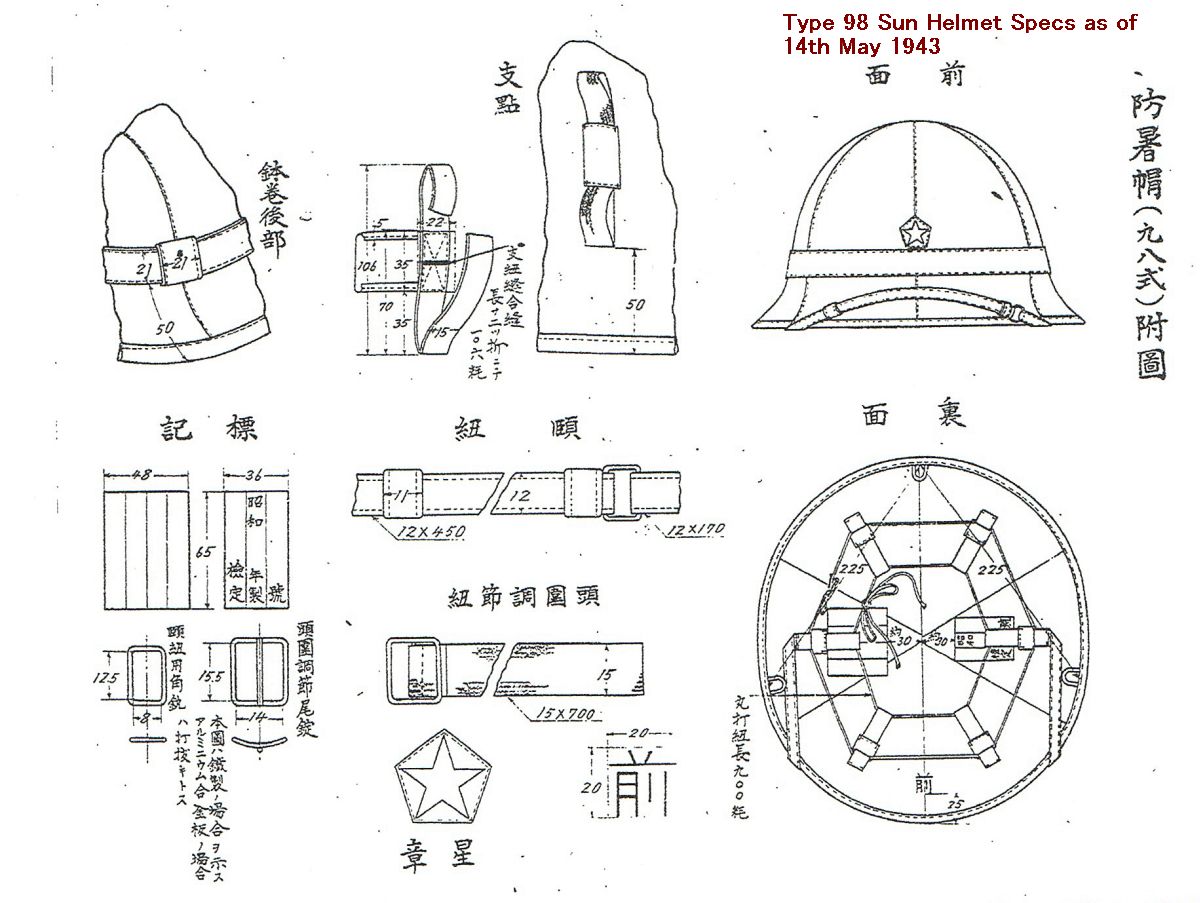
Army Ordinance 66, dated 1st September 1941 announced the further deletion of the top vent and also switched the star emblem from metal to a machine-woven type on a pentagon shaped backing.
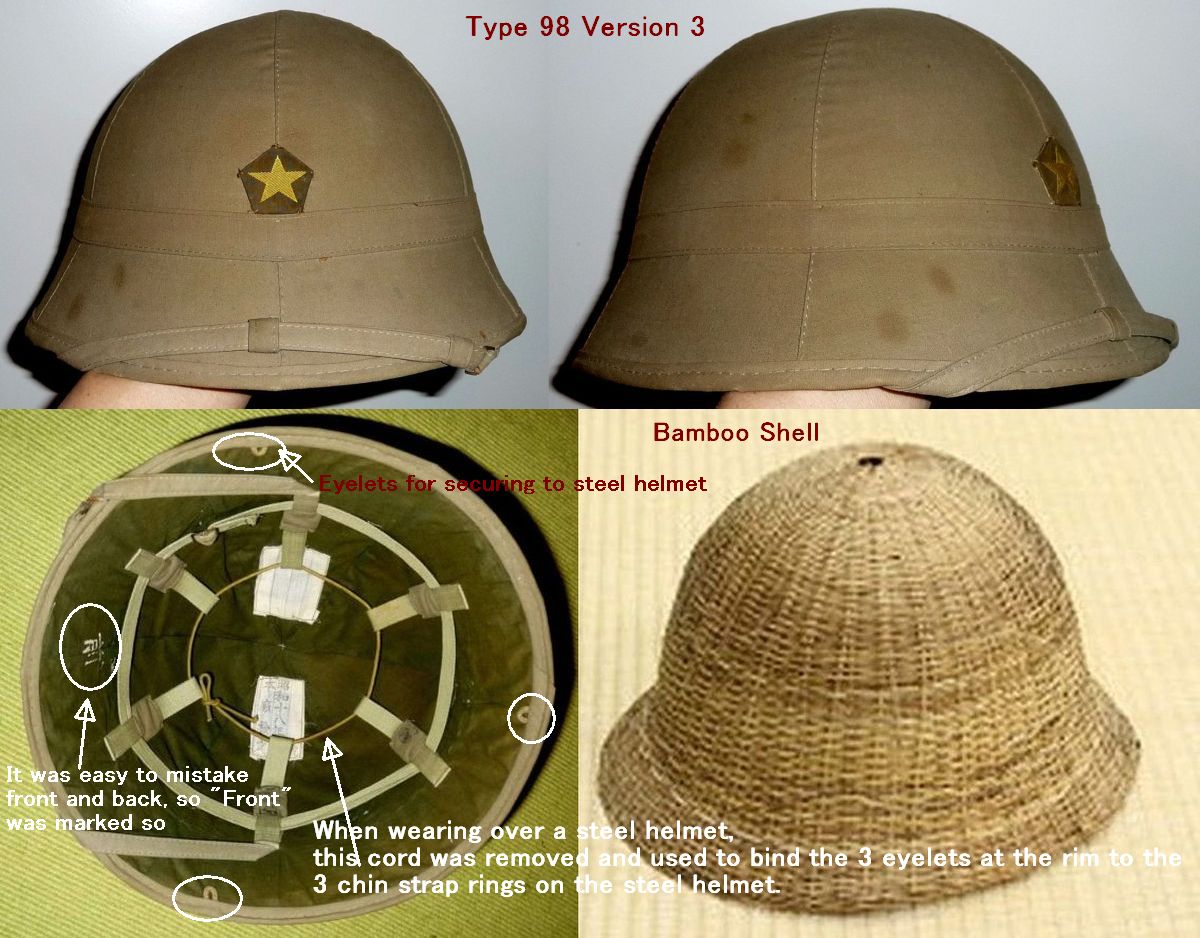
1941 December, Shell Material Substitutes as “B-Spec (ロ号仕様)” Sun Helmets
In December of 1941, the main depot printed a manual on Tropical uniforms and equipment. It shows that by this time a substantial variation of shell material had been approved for sun helmet production.

It described the current model (Type 98 V.3) as having a “bamboo shell” and no air vents. It also touched upon the previous models by saying those models had “felt shells” and existed with a combination of both top and side air vents (Type 98 V.1) or only with a top vent (Type 98 V.2).
It explained further that as “reduced spec substitutes (規格低下品)”, there were shell material choices of thin wood sheets/tape (経木), Sanada (眞田), combination of flax and Sanada (麻眞田併用), chocolate vine (木通 Akebi), Willow (杞柳), Straw (麦桿) and Pandanus (林投).
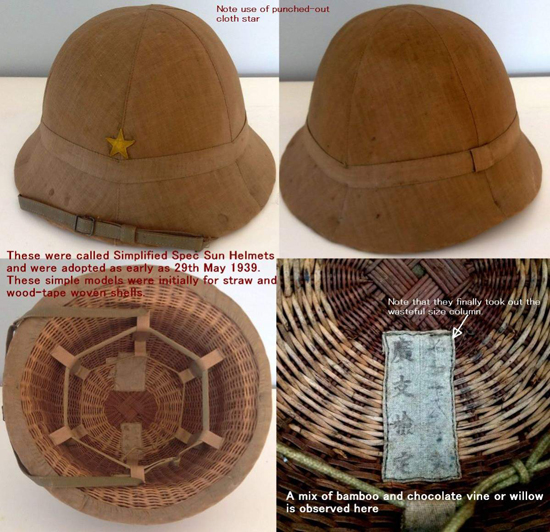
The Army’s official spec book refers to these substitutes as “B-specs (ロ号仕様) and records that the Sanada and flax combination was established as “B” Spec on 26th March 1938 followed by chocolate vine on 6th February 1939 and Willow on 6th May 1941.
The Straw version as mentioned in the Dec. 41 manual also exists in the spec book as a Simplified Spec Sun Helmet (簡易防暑帽), which suggests a simplified construction. For instance, the star emblem specified for this model was the type punched out from yellow wool, like those on the field cap or from artificial leather. Though no drawings are given, it is likely referring to examples without any cloth lining inside, as the materials listing excludes the typical green lining cloth. This spec was established as early as 29th May 1939 and at that time only assumed straw shells or shells woven out of wood tape, but surely other “B-spec” materials were also employed for this design towards the end.
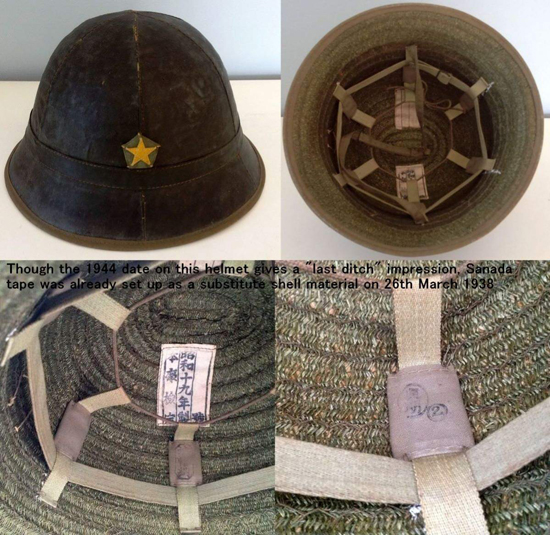
Though such substitute specs are generally referred to as “last ditch”, you will see that they were not late war at all, but all set in place even before America entered the war. In a sense, as you see in the Army’s frantic effort to use any material possible, even by literally “grasping at straws”, the Japanese economy was already at the brink of the last ditch in 1938, and the US trade embargo became the proverbial final straw.
Another sought after B-spec item is the light colored sun helmet that looked white, of The Bridge on the River Kwai fame. No, it was not an officer’s model as some like to think. There was no such thing as an officer’s design, though private purchase sun helmets were sometimes worn. It is only a typical late war compromise in dealing with material shortages.
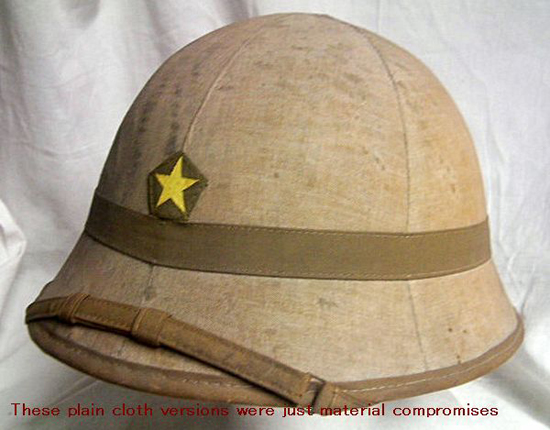
Finally the Sun Helmet B Model (防暑帽乙) “The Mister Ed” Version
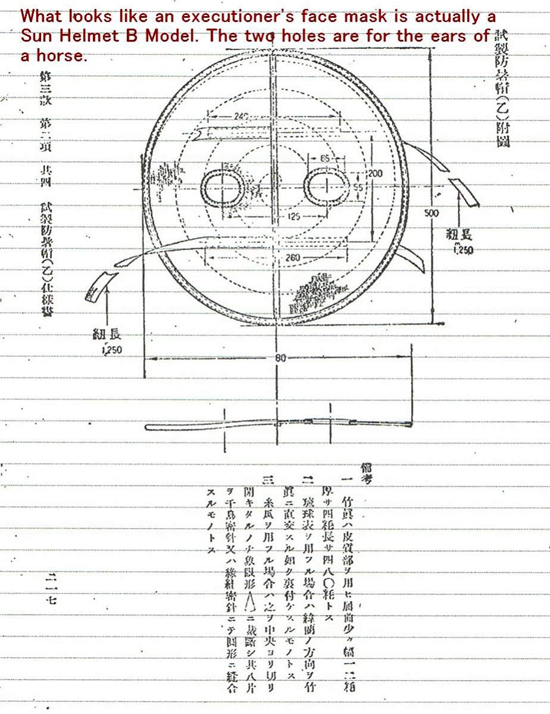
Ever since 12th October 1938, there had also been another less known model of Sun Helmet called the “B Model 乙”, not to be confused with the B-specs just explained above.
In effect, the sun helmets we have been discussing all this time were the “A Model 甲”, though they did not actually use that designation in case of sun helmets.
Those who have read my gas mask story know that since 1932, the IJA used the code “A Model 甲” for humans and “B Model 乙” for horses. So the IJA had sun helmets for horses, too.
This Horse model had gourd sponge/bamboo as core material. Here’s the drawing from the spec book and an “in-use” view from the tropical uniform manual of 1941.
Well, hopefully, all that was not just “Mantra in the horse’s ear “, as the Japanese say of an unappreciated effort.
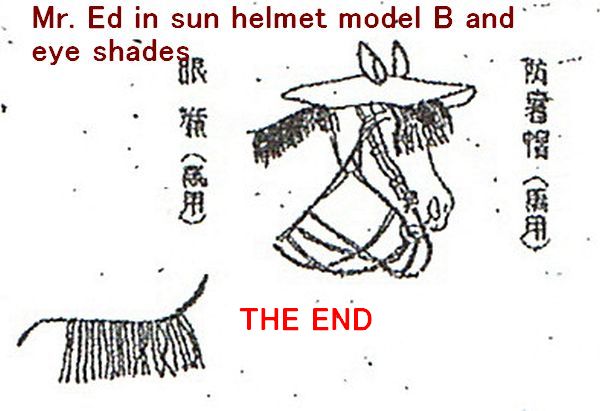
Nick Komiya
October 2016
Our special thanks to Nick Komiya for sharing this fascinating and detailed study of the evolution of the Japanese sun helmets. This study originally was published on the War Relics Forums.
